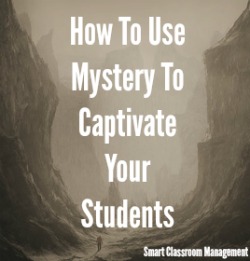 When covering classroom management-related topics and routines, it pays to be highly detailed.
When covering classroom management-related topics and routines, it pays to be highly detailed.
Providing steps for independent work, modeling how not to enter the classroom, teaching the ins and outs of small-group collaboration . . .
Anything and everything that involves what you want your students to do—or not to do—should leave nothing to chance.
When presenting academic lessons, however, although details are still important, captivating attention leapfrogs to the forefront.
Because unless your students are genuinely interested in what you’re offering, then learning and behavior will suffer.
Good teaching requires you to have a quiver of strategies you can draw upon to pique curiosity, activate listening, and shake boredom of its grip.
One of the best ways to do this is with small doses of mystery. When sprinkled here and there like the first wisps of snowfall, it has a unique way of cutting through the distractions of modern childhood, grabbing attention by the lapels and pulling students deep into your lessons.
What follows are four ways to bring this simple but powerful strategy into your classroom.
Begin with a story.
Storytelling is inherently mysterious. Because it invites students to follow along with you down a winding path to who knows where—with uncertainty, surprise, and the promise of revelation waiting around the bend—it builds anticipation and suspense and alights a pressing need to know more.
Although you can use it virtually anytime, anywhere, and with any subject, spinning a good yarn to introduce new units and topics of study is especially effective—because it will generate enthusiasm and interest before you get to the heart of your material.
Never explain how your students should feel.
It’s easy to mistake the call for more detail to include the need to explain to students how they should feel and what they should think about their learning, which removes the mystery and excitement of discovery. This is a common error that effectively turns students off from learning.
Allowing students to think for themselves improves independence, sparks animated conversation, and fills the room with a sense of surprise. It allows them to feel the deep, raw emotions and pure reactions to your words and instruction. It is the very soul of learning, and you never, ever want to remove it from your classroom.
Don’t explain every why.
Another common error is to explain every why to students. The truth is, unless you have a specific reason for doing so, it’s best not to explain why a character did this or that or why a solution works better one way versus another. Provide the what in high relief, but allow your students to work out the why—at least, initially.
It is the mystery of why, after all, that draws students in and gives them reason to care about what you’re teaching. It provides challenge and helps them to see themselves in characters and figures of history, stirring an empathetic point of view that leads to deeper understanding.
Leave blanks to fill.
Although it takes some forethought, leaving strategic gaps of information out of your lessons and stories can fuel great interest. The key, though, is to be sure there are enough clues for students to bridge those gaps with informed predictions.
Great writers do this all the time. Your favorite novels leave blanks of mystery you are made to fill. If they explained everything, you’d have far less incentive to turn the page. The promise of prediction followed by discovery is a powerful allure for students as well.
A Magical World
Some instructional methods emphasize giving away far too much mystery—which removes a natural incentive for learning that all students have in abundance.
The truth is, over-explanation takes the fun and intrigue out of learning. We want our students thinking one step ahead, predicting, turning the page, filling in the blanks, and peeking around the next bend.
We want them invested and engaged and walking lockstep with the characters of the stories we tell. We want them leaning in, eyes dancing, and hearts fluttering, absorbed in the moment.
Like Jane Austin, C.S. Lewis, George R.R. Martin, and every great storyteller, when we infuse our teaching with a sense mystery, when we draw our students deeper into our lessons using their own innate inclination to solve a good riddle and figure out a good why . . .
We usher them into a bright-new, blinking, magical world of learning.
If you haven’t done so already, please join us. It’s free! Click here and begin receiving classroom management articles like this one in your email box every week.

I highly appreciate this classroom management tips they are of great help to me.
You’re welcome, Motale!
Michael
Hey Michael, I just had an incident in class today that really saddens me. We were doing a project and there was a lot of hubbub so my eye couldn’t be everywhere, but kids were working and enjoying themselves, and prior to the end of the period, somebody tells me their phone went missing. (we were using our phones to upload videos of our project)
I kept everyone in for as long as I could hoping someone would return the phone or at least pull a “oh hey, I found it under this book”.
How do you deal with theft in the classroom?
Hi Chuck,
Sorry to hear it. Such a tough issue, and I wish I had an easy answer for you. It can happen in the most well-behaved classrooms. There are things you can do to help ensure it doesn’t happen again–as well as ways of getting to the bottom of it. If you don’t mind, given that others may have the same question, it’s something I hope to tackle in a future article.
Michael